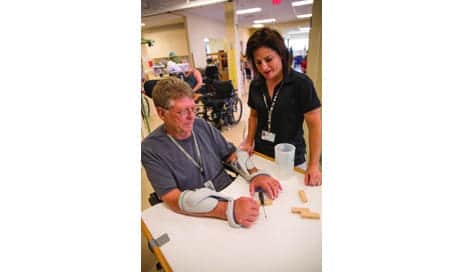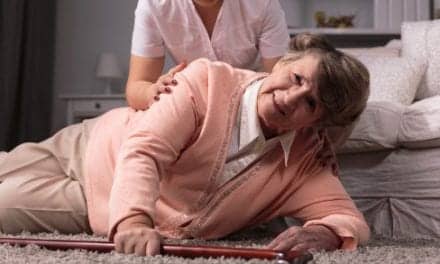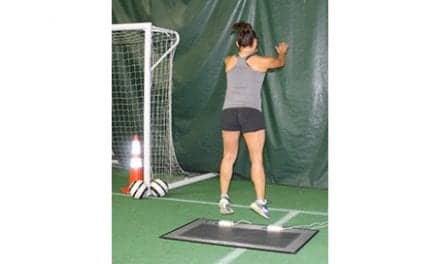by Stephanie Kaplan, PT, DPT, ATP, and George Kopiloff , II, PT, DPT

Stephanie Kaplan, PT, DPT, ATP, Casa Colina Director of Rehabilitation, uses a wireless neuro prosthetic device with a patient to provide electrical stimulation to the upper extremity to enhance function.
Patients affected by orthopedic and neurological deficits traditionally obtain excellent rehabilitative outcomes from a clinical hands-on perspective. Recently, innovations in the high-tech arena have transitioned to the medical field. Those innovations have made their way into many of the devices used in the provision of care, helping patients reap the benefits of highly personalized treatment and supporting superior outcomes.
There are many advantages to using technology in the clinical setting. Among them is collection of real-time objective data on current progress, which can be reported to third-party payors to facilitate reimbursement. Likewise, high-technology solutions also provide the ability for therapists to integrate cognitive and visual challenges into mobility or ADL tasks, as well as enhance movement with motors, sensors, gyroscopes, accelerometers, feedback, and virtual reality environments. Other benefits are improved outcome measure data, increased repetitions for a task, and objective data available to support care.
Rehab Tools with a Reputation Dividend
With a large number of technologies available, there is often a challenge on the decision-maker’s side in selecting devices that are appropriate and fit a facility’s purchase criteria. Many of the advanced rehabilitative technologies offered on the market have a large price tag due to the time and effort invested in product development, testing, and FDA clearance. In an environment in which length of stays and reimbursement are continually being challenged, many facilities expect this equipment to decrease length of stay, decrease FTE requirements, and/or improve functional outcomes.
At Casa Colina Hospital and Centers for Healthcare in Pomona, Calif, experience has proven that new and exciting technologies can help increase clinic volume and awareness in the community, as well as heighten awareness among patients and payors. Moreover, with the rapid development of various technologies, a therapist’s ability to maintain their knowledge of current and best practices is more challenging than ever. Furthermore, the arrival of a new technology at a facility can spark new referrals for services. This is particularly true among today’s well-informed consumers who often have researched their conditions and seek facilities equipped with technologies that will provide specific benefits that aid their recovery. The manufacturer representative has a similar goal of increasing access to their product and is often extremely helpful in directing referrals to an organization where their technology has been purchased.
Answer “Why” Before the Buy
Decision-making for which technology to purchase can be a challenge. Casa Colina has initiated an interdisciplinary committee to review the need, function, and current research available for technology that is being considered. Before a device is considered for purchase, several key criteria must be met. The answers to those criteria are addressed by the following questions: 1) Has a positive trial of the device or equipment been completed with therapists and patients? 2) Is the device easy enough to use so several clinicians can use it? 3) Will the device be available to a large range of clients? 4) Will any special training or certification be required of the clinical staff? 5) Is the benefit of the device significant enough to spend the required resources? 6) What research is available to support the use of the device?
To give therapists flexibility in improving patient outcomes, Casa Colina has acquired many of the high-tech, innovative pieces of equipment seen at state-of-the-art rehabilitation facilities throughout the country. Many of the departments at Casa Colina have access to these life-enhancing devices, designed to optimize healing, function, and quality-of-life measures among patients. For ease of understanding, these technologies are categorized into electrical stimulation devices, walking facilitation devices, and assessment/treatment tools.
[sidebar float=”right” width=”250″]
Innovation Infusion: Even the Rehab Basics Get an Upgrade
Rehab technology has taken on a powerful and attractive high-tech allure in the last decade between powered robotics, prosthetics, and troves of computerized gear. However, even as devices at the high end of the technology continuum seem to add layers of new features each year, workhorses such as treatment tables, cardio gear, and lift systems are also expanding the utility they provide.
A staple in virtually every clinic, today’s treatment tables offer functions that make it easier than ever for therapists to do mat work with patients who use wheelchairs. One manufacturer has developed a power mat platform with an electronically activated hydraulic system designed to lift as much as 1,000 pounds. The lifting range of 30 inches high to 20 inches low can offer a welcome level of safety for patients who need to perform wheelchair transfers to the mat. Therapy tables also offer exceptional flexibility with current models designed to provide split elevation for the leg or shoulder for improved positioning and bilateral functional therapy. It’s not just table features that have improved; one company has changed up the construction materials it uses to build a table and developed an aluminum treatment table. The aluminum construction allows the table to be used in damp environments and still withstand the effects of humidity.
Cardio and resistance training equipment has come a long way since rickety stationary unicycles. Facilities now have the option of providing eccentric resistance strength training to users from a seated position, similar to a recumbent bicycle. Eccentric work provides different benefits from concentric exercises, including higher resistance capacity and lower perceived exertion. Exercises performed in this position can not only improve strength, stability, and balance, but also offer a way for patients who have low cardiac output to effectively increase strength. This trainer also provides data that can record and help track the progress of each leg and reports that document progress.
Patient lifts are another long-standing technology that has evolved to increase safety and flexibility for those who use them. The latest ceiling-installed lift systems can ease wear and tear on caregivers while also reducing the risks associated with performing lifts on wet floors. Among the current generation of ceiling lifts are models designed to provide self-transfer from a mobility device to a bed. For wheelchair users, this function can mean a higher level of personal independence.
—Frank Long[/sidebar]
Electrical Stimulation Devices
Neuro Prosthetics (lower-extremity orthosis, upper-extremity orthosis): These devices have been engineered to provide electrical stimulation to the upper and lower extremity for persons with severe weakness in order to enhance function of the upper extremity or walking. One common challenge of traditional electrical stimulation units is finding the same motor points with each application; the neuroprosthetic devices are set up one time and allow for easy reapplication. One manufacturer offers an upper-extremity orthosis; electrodes target the hand and forearm. One of the therapeutic advantages this device provides is that the user can practice the motion of opening and closing the hand or use it as a neuroprosthetic to pick up and release objects.
Several manufacturers offer a lower-extremity prosthetic used during gait; a charge is delivered to the affected dorsiflexion muscles during initial swing to avoid foot drop. The beneficial effects this device provides include improved safety while walking, as the foot is no longer dragging along the ground; a step length that often is larger; as well as faster gait speed and increased symmetry between the impaired and intact limb. These devices are available for personal use in the home setting, which provides patients a safe means of using electrical stimulation at home along with data available to the clinician on the amount and frequency of use.
Arm and Leg Ergometers: This system uses a series of electrodes applied to muscles of the upper and/or lower extremities to produce a patterned movement enabling the user to cycle. The systems offer a large variety of options for the user that spans passive movement and active muscle stimulation resistance to the muscle. The devices have been used with a wide variety of diagnostic groups, including spinal cord injury (SCI), stroke, multiple sclerosis (MS), and brain injury, to name a few. The devices are easy to use, and at Casa Colina participants can continue to use the devices on a cash-pay basis after traditional therapy is completed.
Walking Facilitation Devices
Transfer and mobility devices: Several devices are available to assist with transfers, standing, and walking. We have identified one device that is successful with all three tasks. The device itself wraps around the torso of the patient securely, while a series of straps are secured underneath the patient, which then attach to the device. Once secured, an electric motor raises the patient into standing, and the patient’s lower extremities are free to move in a reciprocal pattern. There is ample space on either side of the device for a clinician to provide manual assistance to the patient’s affected lower extremity during the gait cycle. This setup provides, first and foremost, a safe environment for both the patient and therapist, decreasing the risk for falling and injury.
Body Weight Support System: The body weight support system installed at Casa Colina allows the patient to be harnessed and connected to a monorail track system from the ceiling. The system can be adjusted to support any percentage of body weight and can limit how far the patient can move vertically to prevent a fall or facilitate greater ranges of motion (eg, lunges, squats, fall recovery). This is an excellent device to mobilize patients that need a substantial amount of support more quickly and can also be used for higher-level-function patients who can use the device with supervision to practice more independent
mobility in a safe setting. Staff members at Casa Colina report that they find this device helpful for two distinct patient populations: 1) Early mobility of patients who require more than one person to maintain an upright position, and 2) Increase independence and active learning for patients who need very little assistance.
Motorized elliptical trainer: This motorized elliptical system has integrated sensors to determine the user’s level of effort and responds to provide the appropriate level of support. The device is designed for a person to work on the reciprocal qualities of gait. A therapist can set desired target repetitions per minute, adjust stride length, as well as dynamic or static handholds. Many Casa Colina clinicians have noted the intense cardiovascular challenge that this device provides for persons who have chronic disease and limited access to devices that are safe to use.
Exoskeleton Systems: One commercially available robotic exoskeleton is available on-site to help persons who are affected by severe weakness, allowing them to walk again. One of the devices is designed specifically for persons who have a spinal cord injury. Casa Colina offers a clinic for this device 2 days per week, and patients have the opportunity to be assessed for this device after a brief screening is completed by the device’s manufacturer. One individual has obtained his personal device and is completing training with his attendant. Other robotic exoskeleton devices are commercially available and designed for persons with a variety of neurologic diagnoses in which upright standing and walking has been affected due to muscle weakness. These devices are available for use in the clinical setting with supervision by a physical therapist.

Stephanie Kaplan uses arm and leg ergometers with electrodes applied to muscles of the lower extremities to help produce a patterned movement, enabling the user to actively cycle.
Assessment / Treatment Tools
Computerized balance system: Casa Colina installed a computerized balance system which targets specific balance deficits. The device is helpful in determining deficits in the somatosensory, vestibular, and/or visual systems. A dynamic force plate and surrounding walls provide the patient with an array of challenging scenarios to assess their balance reactions in real time. A computerize report is then generated, displaying the areas of deficit, acting as a road map to aid the therapist in designing a specific plan of care for the patient. The system is well-designed for assessment and treatment with continued feedback for the user and therapist.
Gait Assessment: This portable tool assesses the temporospatial aspects of walking with a database of normative data. Participants walk across the mat, which has embedded pressure sensors, at their self-selected walking speed with or without assistive devices. Data is easily and quickly processed and can be used as a patient education tool as well as support for clinical decisions. The device can measure walking speed, cadence, stride length, step length, and other measures.
Treatment Tables: Though not necessarily considered “high-tech,” treatment tables are a staple among the facility-based equipment needs at most rehab facilities, and are routinely replaced or upgraded as wear sets in or new features become available. Among some of the features that are useful for these types of purchases are electric motorized hi-lo treatment tables, multi-position treatment tables that facilitate a wide variety of therapy and treatment functions, and tables designed for use with bariatric patients. RM
Stephanie Kaplan, PT, DPT, ATP, is the Director of Rehabilitation and Director of the Neurologic Physical Therapy Residency Program at Casa Colina. She has been involved in the care of persons with neurologic impairments for over 15 years.
George Kopiloff, II, PT, DPT, has over 15 years of experience and treats Casa Colina patients in an outpatient neurological setting as well as manages a pulmonary wellness program. He has been an APTA-credentialed clinical instructor for several years and is actively involved with Casa Colina’s student
mentorship program. For more information, contact [email protected].






You’ve got it in one. Co’ndlut have put it better.